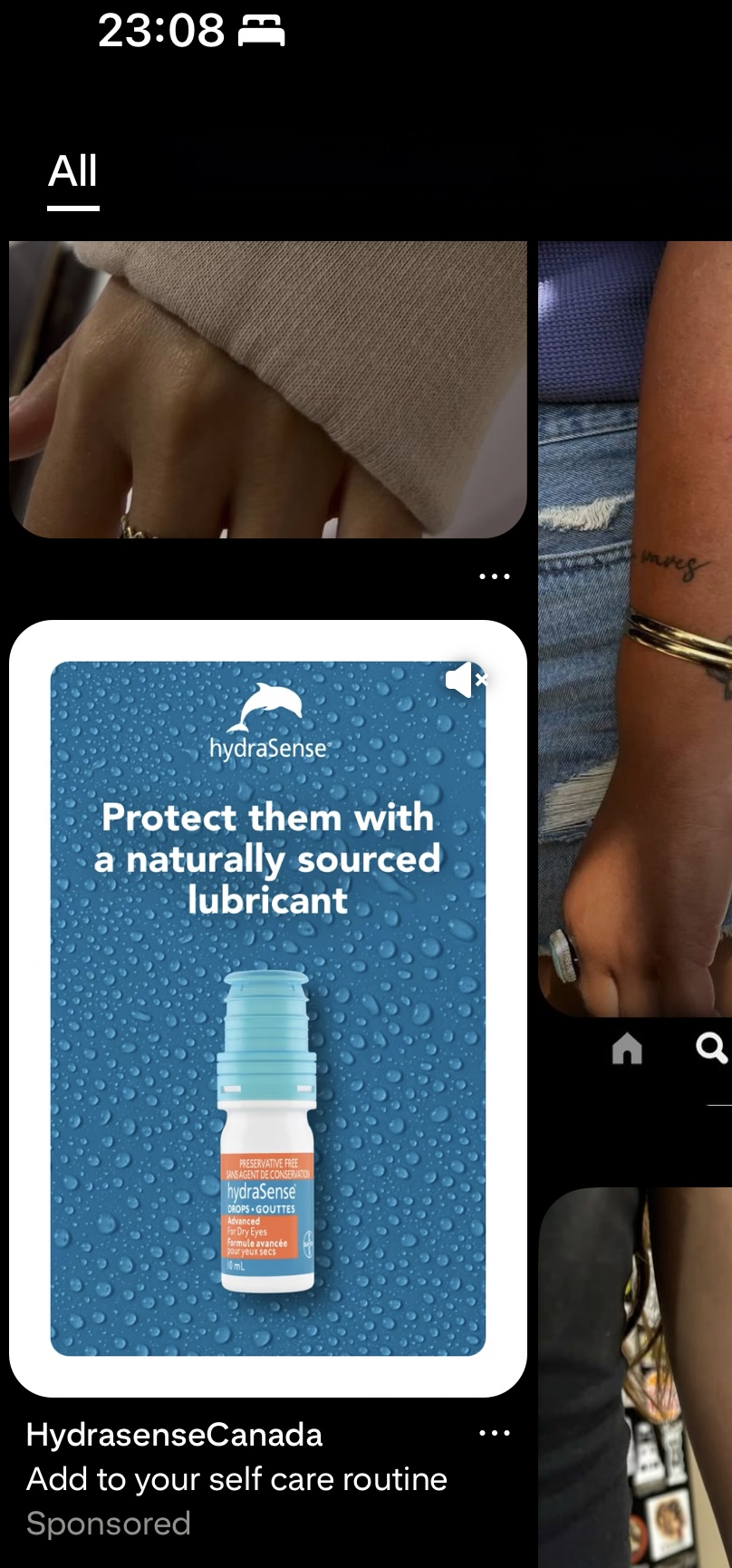This advertisement is from HydraSense Canada, a company known for its eye care products- especially lubricating drops for people with dry eyes. The ad’s message is straightforward: it’s promoting a preservative-free, naturally sourced eye lubricant intended to help people find comfort and relief from dry or sensitive eyes. The ad appears as a still image, with a short message and a photo of the product.
Visually, the ad features a small, white, and turquoise bottle of HydraSense eye drops set against a blue background dotted with water droplets. Above the bottle, a large white text reads: “Protect them with a naturally sourced lubricant.” The brand’s dolphin logo appears above the text, evoking an association with water, nature, and purity. From top to bottom, the advertisement follows a simple, vertically centered position. At the top is the HydraSense dolphin logo. Below it sits the bold, white slogan against a blue, water-like background. In the middle, the eye drops bottle stands upright, brightly lit and sharply focused. The background texture of water droplets suggests freshness, hydration, and natural purity. The color palette reinforces this: predominantly blue and white, colors commonly associated with cleanliness, health, and trust. The orange text on the bottle (“preservative-free”) stands out as a key detail, emphasizing product safety and differentiating it from competitors.
The central message is clear: HydraSense protects the eyes with safe, natural, and adequate hydration. The phrase “Protect them” personifies the eyes, positioning them as vulnerable entities requiring care and protection. This language creates an emotional appeal to consumers who may already feel discomfort or worry about their eye health.
The ad employs these key pictorial elements:
• Water droplets signify natural hydration, purity, and life, reinforcing the product’s association with being “naturally sourced”.
• The dolphin logo symbolizes nature, playfulness, and intelligence, indirectly suggesting that HydraSense shares these values.
• The color blue is significant in advertising theory as it evokes trust, calmness, and a sense of hygiene.
I think the image is effective in conveying the message to the target group due to its presentation, including the color palette and product placement. The product is directed to anyone with sensitive and dry eyes, which is a very common symptom today because of how many screens the human eye is exposed to. Looking at this ad, it gives a sense of hydration and comfort, giving the idea that it is going to get rid of your symptoms. It is also effective for consumers who prioritize natural, safe, and naturally sourced products. The message is very convincing, stating that it is going to protect your eyes. Combined with the color palette and the droplets in the background, it looks very convincing. The effect the ad has on me is that suddenly I feel my eyes very dry and need them to be hydrated and protected, and having the feeling of refreshment and relief after using it just like the ad shows it.
I recognized Hydrasense because I am familiar with their nasal products, although I’ve never tried their eye care products. HydraSense is owned by Bayer. Bayer introduced the HydraSense brand of saline nasal and eye care products in Canada and the U.S. starting in 2017. Bayer is a well-known pharmaceutical company that creates and distributes different products. When talking about their environmental and manufacturing practices, there are a lot of critiques. One of the main reasons is that Bayer is violating the OECD Guidelines for Multinational Enterprises by promoting an agricultural model in South America that leads to food and water shortages and pollution, massive deforestation, biodiversity loss, negative health impacts, and land conflicts with local indigenous and peasant communities which ended in a lawsuit (ECCHR,2024)1 There is also another article that focuses on studying Bayer’s communication to its consumers and if they are actually saying the truth when it comes to sustainable practices: “Bayer should work to make their actions more congruent with their words in terms of their deeds, data, and results. This research calls for a larger discussion on advocacy and the change needed amongst for-profit sectors. The above courses of action provide Bayer and other large 50 corporations with alternative methods for authentically participating in more sustainable, regenerative practices.” (Davis, K. 2021)2 There have also been some concerns about the ingredients they use for their products. A consensus statement raising concerns about environmental, human health risks of glyphosate-based herbicides (which are core to products sold by Bayer/Monsanto). Covers endpoints like endocrine disruption, carcinogenicity, regulatory gaps.( Myers, John P., Michael N. Antoniou, Bruce Blumberg. 2016)3 And also the toxic traits left behind by Bayer, “Companies such as Bayer have left a toxic trail all around the world and all through their long history. Bayer’s model of production, and many of its products, have been a past, present and future threat to people and planet, and need to be regulated. Around the world, Bayer’s modus operandi is not to work in the public interest, but rather to capture public policy to serve its private interests and dividends of its shareholders, all while ignoring the public health and environmental impact of its activities.”(Corporate Europe Observatory, 2024) 4
Consumer critiques, lawsuits, and articles have led to some changes in Bayer’s practices, including product line changes (residential glyphosate), improved transparency, settlements, changes in packaging & external oversight. But many of these changes are narrow in scope or defensive in nature. Whether these will cumulatively lead to substantial shifts in their environmental footprint or core manufacturing practices remains an open question.
The HydraSense advertisement successfully conveys a message of hydration, purity, and protection, appealing to consumers’ emotions and health concerns through its visual design and messaging. However, when placed in the broader context of Bayer’s ownership, it also reflects the tension between consumer-facing branding and the company’s contested environmental and manufacturing practices. While HydraSense promotes natural, preservative-free care, Bayer as a corporation continues to face significant critiques for environmental damage, questionable sustainability claims, and harmful agricultural practices. Ultimately, the ad is effective in marketing HydraSense as a safe and natural product, but the company’s broader track record complicates the message, raising important questions about the gap between branding and genuine corporate responsibility.
Bibliography
Corporate Europe Observatory. Bayer’s Toxic Trails. September 2024. https://corporateeurope.org/en/2024/09/bayers-toxic-trails.
Davis, Korrin A. Bayer’s Dual Messaging: A Comparative Analysis of Its Regulatory Filings and Promotional Communication Claims. Master’s thesis, California State University, 2021. https://scholarworks.calstate.edu/downloads/zk51vp210.
European Center for Constitutional and Human Rights; CELS; Terra de Derechos; BASE IS; Fundación TIERRA; Misereor. “OECD Complaint Filed Against Bayer AG for Systematic Human Rights Violations and Environmental Damages.” Press release, April 25, 2024. https://www.ecchr.eu/en/press-release/oecd-complaint-filed-against-bayer-ag-for-systematic-human-rights-violations-and-environmental-damages/.
Myers, John P., Michael N. Antoniou, Bruce Blumberg, et al. “Concerns over Use of Glyphosate-Based Herbicides and Risks Associated with Exposures: A Consensus Statement.” Environmental Health 15 (2016): 19. https://link.springer.com/article/10.1186/s12940-016-0117-0


Provide Feedback